
Nos. 41 High Street (The Dolphin Hotel)
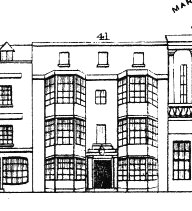
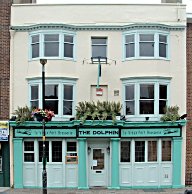
The Dolphin Hotel is the only building in the immediate vicinity to have survived the bombing in World War 2 practically intact. We can therefore use the 1842 Charpentier drawing and a modern photograph to assess the degree of change in the intervening years. The well known photograph taken from outside the hotel in 1868 (below left) allows us to confirm some of the deductions.
The earlier two images confirm that modifications were made to the building between 1842 and 1868 though we do not know exactly when this occurred. The 1868 photograph suggests that very few alterations were made between that date and the modern era. The main pillars either side of the door are certainly in place throughout. The bay windows to the first and second floors seem to have altered little, but the third floor has lost it's blind windows, presumably at the same time that the parapet was lowered.
At ground floor level, the 1868 photo does not offer many clues as to the configuration of the windows but as the pillars and the canopy seem to have been retained into the 21C it may not be unreasonable to assume the windows have been as well. Certainly the area between the pillars today appears to be of some age.
Although The Dolphin as it appears today (2008) is physically shorter than it was in 1860, it is assumed that the cornice at the top of the second floor is still in the same position and from this it's height above street level may be calculated by counting the number of brick courses on the adjoining building up to that level. Since the latter is modern we can assume that 10 courses represent a height of 30 inches. By extending this rule from street to cornice we get a height of 27'6", and by further extension, the height of the building in 2008 is 31'0". The amount by which the building was shortened can be determined by looking at a photo (below, right) of the Guildhall next door which also shows the Dolphin before alteration. This suggests a difference of 4'6", giving an overall height in 1860 of 35'6".
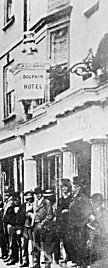
The width of the building would normally be scaled from the 1861 Ordnance Survey map, but there is a problem in that the cartographer has failed to include a boundary line between the Dolphin and No. 40 High Street. We know that this is a mistake and not that the Dolphin did at that time occupy both premises as all the Trade Directories list a separate occupant at No. 40. Fortunately the Dolphin still exists and so we can measure it's frontage on the ground and this gives a width of 29 feet.
This width contrasts with that obtained by measuring the entire distance between Pembroke Street and Grand Parade and dividing that length according to the relative widths of the buildings in the Charpentier drawing. Using this method the Dolphin should have been 27'6" wide or about 5% less than the physically measured distance. From this we can confirm that the Charpentier drawing cannot be relied upon for any dimensions.
Documentary Evidence
Although Charpentier does not name the building at No. 41 it is known that it was the Dolphin Hotel in 1842, as it is in 2008. It was first granted a licence in 1716 [Pomeroy] and was owned by Andrew Plyer Martell prior to 1802 when Charles Thomas Jnr. took over. It was sold by auction in 1840, being described as a "well accustomed, highly respectable freehold inn and tavern - most advantageously placed" [Hampshire Telegraph]. From the date of it's sale, possibly to William Bond, it was further licensed for entertainment, including songs, bands and even ballet.
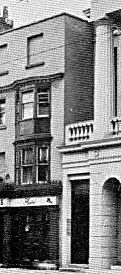
All of the Trade Directories between 1852 and 1865 list the Dolphin, though some refer to it as the Dolphin Hotel. In 1852 the landlord was David Roberts [Hunt's Directory] and in 1859 it was William Bond [Post Office and Kelly's Directories] who was also listed by Harrod's Directory in 1865, though it gives the number of The Dolphin as 42 High Street. In addition, William Bond is described as being the owner of American Bowling Alleys and Billiard Rooms at the same address (in October 1867 Bond put a notice in the Hampshire Telegraph saying that the firm of Burroughs and Watts were building him a new Billiard table). Many years later, in 1914, James and Grace Innes were the incumbents [Kelly's Directory] and their son Henry Pembroke Innes volunteered for the Devonshire Regiment shortly after the outbreak of the Great War. He was killed on 27th May 1918 (aged 39 years) and is commemorated on the WW1 Memorial outside the Cathedral, almost opposite the Dolphin.
In the 1861 Census, Schedule 29 lists William Bond (44, Victualler), his wife Caroline (43), son William (19, Shipwright), son George (16), daughter Kate (15), daughter Caroline (14), son Frederick (12) and son Harry (11) with Elizabeth Clark (24, Cook), Ann Smith (26, Housemaid), Frederick Sayer (18, Lodger, Billiard Marker), Thomas Bartlett (35, Lodger, Bookmaker) and Eliza Hillman (35, Lodger, Housekeeper).
Summary
The 1868 photograph gives a strong indication that the building has remained much the same in 2008 and will be the basis for the model. The fluted columns either side of the door represent a real challenge in terms of modelling as they are not tapered linearly but rather, have a convex taper, which is beyond the current skill set. The ground floor windows will have to be taken entirely from the modern building as the 1868 photo gives no clear indication of their layout, but this may not be wide of the mark as the existing windows show signs of some age.
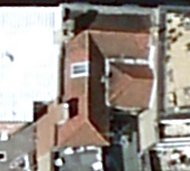
An image from Google Earth suggests that the configuration of the Dolphin roof has remained substantially unaltered. However, there is some indication that the roof base is at second floor ceiling level in the modern building and if this reflects it's position in 1868 then the "third floor" with the blind windows would have been no more than a parapet, placed there perhaps to enhance it's status next to the Guildhall against which it would have otherwise looked rather puny. This might also explain why it was no problem to lower the level of the parapet and fill in the blind windows once the Guildhall had been demolished. This supposition may be supported by the Charpentier which shows no roof at all, exactly what we would expect if the roof were sitting behind the parapet. The Google image also indicates the possible relationship between the main building and the part containing the Bowling Alley at the rear.
The 1868 photograph shows an elaborate hanging sign above the front door advertising Billiards as well as the hotel. It is indistinct in places and would be difficult to model in any case. There may be another sign on the canopy over the door but as it is so vague it will not be included in the model either.
Once again we are bedevilled by the lack of information about colour. The photograph suggests the walls and ground floor are white or of a very light colour but the first floor windows appear to be darker. Another guess is required.